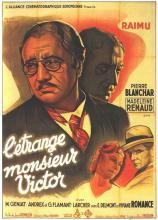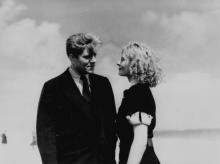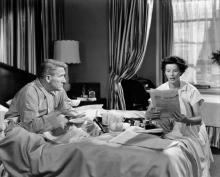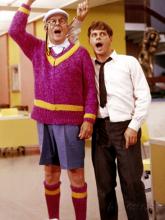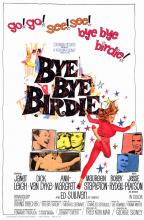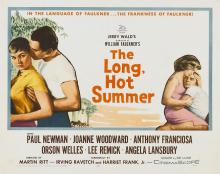These notes on Jean Grémillon's Lumiere D’Ètè ("Summer Light", 1943) were written by Jonah Horwitz, Ph.D candidate in UW Madison's Department of Communication Arts. Marking the conclusion of our Jean Grémillon series, a 35mm print of Lumiere D’Ètè will screen in the Cinematheque's regular location, 4070 Vilas Hall, on Saturday, October 3 at 7 p.m.
By Jonah Horwitz
Lumière d’éte is an unusual movie made in unusual conditions. Although often described as the second of Grémillon's films made under the Occupation, it was really his first, as Remorques, released in late 1941, was written and shot largely before the fall of France in summer 1940.
The German invasion scattered French filmmakers around the country—and the globe. Some went to California, others to Great Britain. But many found themselves in a kind of internal exile. One sizable colony of film professionals gradually established itself in Provence, on the Côte d’Azur (then part of Vichy France and ruled by Marshall Pétain). Some members of this colony were banned from making films as a result of their left-wing associations. Others, like art director Alexander Trauner, were Jews. Their presence—and their participation in filmmaking—was a kind of open secret. Tolerated by the local police and protected by well-connected producers, they spent much of the Occupation in a milieu that, according to film historian Colin Crisp, mingled a "surface tranquility, continuing professional involvements, and the ever-present possibility of death." Members of this colony formed a professional society, with close ties to the Resistance, in order to help organize film production in the French Riviera. By legend, some directors organized location shoots as pretexts for clandestine rendezvous.
Lumière d’été’s screenwriter Jacques Prévert was something like the sponsor of a group of filmmakers at Tourrette-sur-Loup. When he was working on a film, he could get work for his colleagues—even those, like Trauner, whose names could not appear in the credits. (On Lumière d’été, Trauner’s friend, the artist Max Douy, was named instead.) Prévert, whose last prewar project had been Remorques, spent the first year of the occupation working on two scripts, for Les Visiteurs du Soir ("Night Visitors") and Lumière d’été; the former became a much-admired film as directed by Marcel Carné (1942).
Lumière d’été’s producer, André Paulvé, was well placed to help organize production in the Côte d’Azur. He was based in Nice, and since 1939 had enjoyed a coproduction arrangement with northern Italian financiers, under the name La Société cinematographique mediterranéenne d'exploitation ("The Mediterranean Film Distribution Company"). Paulvé was responsible for several notable French films of the Occupation period: not only Visiteurs du soir and Lumière d’été but also the first films by Jean Delannoy, who would become a major figure of the postwar "tradition of quality."
Prévert wrote Lumière d’été with Jean Gabin and Michèle Morgan, the stars of Remorques, in mind. But by the time filming could begin, both were in California. Two relatively minor actors, Madeleine Robinson and Georges Marchal, were instead cast. After Paulvé hired Grémillon, the latter hired his favorite actress, Madeleine Renaud. At this point in her career, Renaud—a celebrated stage actor and member of the Comédie Française—was fed up with filmmaking and was reluctant to appear in any films but Grémillon's.
Lumière d’été is set in the French Alps. There, Patrice (Paul Bernard), a manipulative aristocrat, owns a lavish chateau. His lover, Cricri (Renaud), runs a nearby inn. Julien (Marchal) is the chief of the workers at a nearby mine. The plot is set in motion when Cricri invites Roland (Pierre Brasseur), a troubled young artist from Paris, to the inn. Roland’s partner, Michèle (Robinson), arrives first, and Patrice immediately sets his sights upon her. Eventually, Roland arrives—as a shell of a man, demoralized by the critical and public rejection of his work. While fending off the overtures of Patrice, Michèle is drawn to Julien. The film proceeds by a series of seductions and repulsions, insinuations and bold declarations. The romantic intrigues are resolved, violently, at a masked ball at Partice’s chateau.
Lumière d’été contrasts the decadence and moral decay of the elites, personified by Patrice and abetted by Cricri, with the efficacy and bravery of the working class, embodied in Julien. Michèle is the in-between figure who must choose sides. The film is rather stranger than this schematic description suggests, however. This strangeness resides in the strikingly non-naturalistic quality of the cinematography, sound design, and lighting; the melodramatic shifts in characters’ desires and actions, which seem to operate outside of conventional psychology; and in the theatrical, sometimes mannerist performances (Brasseur’s in particular). As many critics have noted, the film seems to take place in a fever-dream.
The film incudes stylistic flourishes that recall Grémillon’s origins in the silent cinema. The montages of mine workers, rhythmically edited like the scenes of the ship’s engine in Remorques, suggest Fritz Lang’s Metropolis in their odd angles and complex layering of smoke, fog, and diffused light. In its use of subjective sound, Lumière d’été recalls Grémillon’s La petite Lise. However, the new re-recording technology introduced to the French film industry by the Germans enabled Grémillon and his recordist Robert Ivonnet to manipulate the film’s sonic texture in a more virtuosic, and less obviously disruptive, way than in the earlier film.
Although the tone of the two films is markedly different, there are many elements in Lumière d'été that suggest Prévert and Grémillon were inspired in part by Jean Renoir's La Règle du jeu (1939). Philippe Roger enumerates the borrowings in a piece on Grémillon's film: characters representing different elements of society converge on a country estate; a failed artist (Roland in Lumière d'été, Octave in La Règle du jeu); a hunting party; the presence of music boxes. Other parallels would require spoilers, but will be evident to those who watch both films.
As with La Règle du jeu, the isolated location and the emblematic characters have prompted critics to read Lumière d'été as an allegory of French society. And many have indeed viewed it as a Resistance parable, promising a victory of the common man over elites who have brought civilization to ruin. Geneviève Sellier views the film as a deliberate attack on Pétainist ideology, depicting rural France not as a wellspring of positive national values but as a site of moral rot. Cited as evidence for these interpretations is the fact that Paul Morand, an anti-Semite who oversaw film censorship for the Vichy regime, had tried to ban the film. Morand saw in Lumière d’été an echo of the "poetic realism" that Prévert had pioneered in the 1930s—a style they associated not only with the left-wing Popular Front but with a pessimism and sense of futility the Pétain regime blamed for France’s defeat.
It’s common practice for critics to treat any and all art produced under difficult and censorious conditions as allegories—subversive attacks on the powers-that-be. This temptation has been especially great for postwar French critics and directors reflecting on the Occupation period; who wouldn’t want to demonstrate that a film you admire—or a film you made—carried a coded message against the oppressors? In this fashion, nearly every major film of the era—up to and including Henri-Georges Clouzot’s Le corbeau ("The Raven"), which was mercilessly attacked by the Resistance press as being "anti-French"—has been rehabilitated as anti-Fascist. This revisionism has the added benefit of making the Vichy censors look like dupes.
The readings of Lumière d’été as a "film of the Resistance" can seem willful. The celebration of the working man, and the jaundiced portrayal of the wealthy, is a commonplace of melodrama. Indeed, the glorification of the "average Frenchman" was a part of Pétainist ideology. At least one critic, Raymond Borde, has attacked Lumière d’été as being essentially consonant with the values of the Vichy regime. (For a sensitive English-language interpretation of Grémillon’s Occupation films as films of the Resistance, see Jonathan Rosenbaum’s essay "Bravery in Hiding": http://www.jonathanrosenbaum.net/2015/09/bravery-in-hiding/) Here I should probably note that Lumière d'été was not banned (contrary to many English-language sources). Morand was overruled by Louis-Émile Galey, Vichy’s official liaison to the film industry, and the film was widely seen. Colin Crisp notes that its happy ending—which contrasts sharply with the tragic endings of Prévert’s 1930s films—might have been the deciding factor. Galey may also have been concerned not to waste the investment made in the film in a time of scarcity, or even worried about offending Paulvé’s Italian partners. Morand was forced to resign over the affair and ended up as Vichy’s ambassador to Switzerland—not a bad place to wait out the war.
As for Grémillon himself? His longstanding association with both trade unionism and socialism made it easy to credit his Occupation films as harboring covert Resistance messages. Less sympathetic critics pointed out that he had made several films at the German studio UFA in the mid-late 1930s. Gueule d’amour (1937) and L’Étrange Monsieur Victor (1938) were shot largely in Berlin, well into the National Socialist period. But such co-productions had been a mainstay of European cinema since the early 1920s, and other filmmakers with left-wing commitments had similarly participated in UFA productions.
In truth, it’s just not possible to read Grémillon’s ideological commitments—or even his relationship to the day-to-day reality of Occupation—into his features. His second and last Occupation feature, Le Ciel est à vous ("The Sky Is Yours," 1944), has if anything an even more ambiguous relationship to its historical moment than Lumière d’été. After the war, Grémillon sought to make a number of historical dramas, among them a feature about the Paris Commune, that better expressed his political views. But he wasn’t able to get any of those projects off the ground. His three postwar narrative films are all melodramas, far removed from any topical associations.


